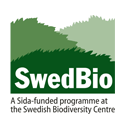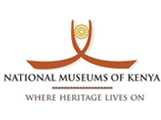Scientific Classification
Species in the Genus
Species in Kenya, Tanzania & Uganda
Description
Possible Causes of Confusion
Distribution in Kenya, Tanzania & Uganda
Habitats
Nesting
Crops Visited
Other Plants Visited
Economic / Ecological Importance
Threats
Conservation and Management Practices
Legislation (National and International)
References
Editors
Acknowledgements
Contact
Click on images to enlarge
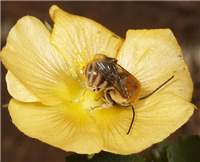
Tetraloniella species. ©Bernhard Jacobi
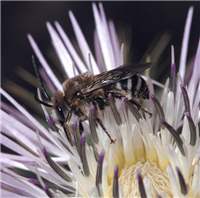
Tetraloniella hohmanni. ©Bernhard Jacobi

Tetraloniella braunsiana (female) - pinned specimen. Photo: Connal Eardley
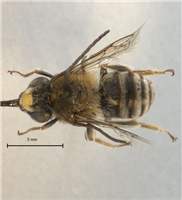
Tetraloniella braunsiana (male) - pinned specimen. Photo: Connal Eardley
Summary
Honey bees are not the only bee species that are significant for human wellbeing. Tetraloniella bees are a group of native bee species that do not produce honey but are important pollinators of crops and wild plants. Females have a sting, but they are not aggressive and will only sting if handled. Tetraloniella bees are solid looking medium-large hairy bees that are often striped. Males have long antennae . They nest in the soil and live independently (i.e. they are solitary). This fact sheet provides information about these bees to encourage farmers to understand and protect them to help ensure that their crops are effectively pollinated.
From a conservation and agricultural standpoint it is not necessary to recognise all the different bee genera. However, it is important to know that there is a large bee biodiversity. Different bee genera pollinate different plant species, although there is some overlap that acts as a buffer as bee populations wax and wane. For healthy ecosystems, including agro-ecosystems both diversity and abundance in the bee fauna is important.
Common Name (Language)
Long-horned bees (English)
Scientific Classification
Kingdom: Animalia
Phylum: Arthropoda
Class: Insecta
Order: Hymenoptera
Family: Apidae
Subfamily: Apinae
Tribe: Eucerini
Genus: Tetraloniella Ashmead, 1899
Species in the Genus
Over 120 species belonging to the genus Tetraloniella have so far been recorded in the world. Most species are known from
Species in Kenya, Tanzania & Uganda
Fewer than 10 Tetraloniella species are known from Kenya, Tanzania and Uganda (Eardley and Urban 2010).
Description
Tetraloniella bees are not well known by local people (including farmers) in East Africa, where the name bee is generally thought only to apply to honey bees. However, many local people who see Tetraloniella bees at flowers will possibly know that they are bees but think that they are honeybees. They are medium-large sized bees that resemble honeybees. They often have a striped abdomen and the males have long antennae . They are frequently found foraging in shaded environments.
Possible Causes of Confusion
These bees can be confused with honey bees because they are similar in size. They can also be confused with some Megachile bees (leafcutter and dauber bees) and those in the genera Tetralonia, Amegilla and Anthophora. They can be easily differentiated from honey bees as they do not have colonies and carry pollen in hairy brushes on the hind leg while honey bees have a pollen basket. Tetraloniella bees do not use leaves, as do most Megachile species, to construct their nests.
Distribution in Kenya, Tanzania & Uganda
Tetraloniella bees can be found in most districts and agro ecologies, from lowlands and coastal lands to the highlands. They will be found in forest lands, shrub lands, rangelands, farm lands, marshlands, plains and plateaus. Farmers can assist in reporting the presence of these bees in their neighbourhood. This would improve our knowledge of their distribution in the region.
Habitats
Tetraloniella bees are common in farmlands particularly those with some set-aside lands that can provide shelter and nests. They are also abundant in areas surrounding natural habitats. These bees are frequently observed in savannah and woodland and swamp edge habitats.
Nesting
Tetraloniella are solitary bees that nest in the soil located in dry places.
Crops Visited
Tetraloniella bee species in
Other Plants Visited
Tetraloniella bees visit various wild plant species from various families, notably those in the Amaranthaceae, Malvaceae, Solanaceae and Asteraceae families.
Economic / Ecological Importance
Little information exists on the usefulness of these bees to the lives of the people in
Threats
In
Conservation and Management Practices
There are now concerted research efforts in the region to develop best practices for conservation and management of bees to enhance crop production. Theoretically, bee conservation and management is inexpensive and adopted activities can also improve the aesthetic value of the landscape. Such practices involve setting land aside (e.g. a 1-metre strip) in the farmland to host all year round food resources for the bees, as well as safer sites for nesting, mating, resting and refuge from natural enemies. During flowering, farmers should manage pesticide usage carefully to avoid poisoning flower-visiting bees. Farmers should also minimise pesticide drift from the field to adjacent areas. Laws governing registration and use of plant protection products also indirectly play a major role in the protection of pollinators. Wood collection should be managed to conserve nesting sites these wood-nesting. KARI (the Kenya Agricultural Research Institute) is developing protocols for mass rearing of different species of solitary bees. Any successful results from this research will be freely communicated to the public. In addition, KARI is collaborating with other stakeholders to ensure in situ conservation and management of bees for pollination purposes. Much of the work of conserving native bees will be underpinned by raising public awareness of the importance of these species.
Legislation (National and International)
There is not yet any legislation in
References
1. Eardley CD, Gikungu MW and Schwarz MP (2009) Bee conservation in Sub-Saharan Africa and
2. Eardley CD, Kuhlmann M and Pauly A. (2010) The Bee Genera and Subgenera of sub-Saharan
3. Eardley CD and Urban R (2010) Catalogue of Afrotropical bees (Hymenoptera: Apoidea: Apiformes). Zootaxa, 2455: 1–548
4. Michener CD (2007) The Bees of the world, the John Hopkins University Press,
5. Eardley CD and Brooks RW (1989) The genus Anthophora Latreille in southern
Editors
Théodore Munyuli, Busitema University - Uganda; Muo Kasina, Kenya Agricultural Research Institute (KARI) - Kenya; Juma Lossini, Tropical Pesticides Research Institute (TPRI) – Tanzania; John Mauremootoo, BioNET-INTERNATIONAL Secretariat – UK; Connal Eardley, Plant Protection Research Institute (PPRI) – South Africa.
Acknowledgements
We recognise the support from the Kenya Agricultural Research Institute (KARI), Tropical Pesticide Research Institute (TPRI) –
Contact
BioNET-EAFRINET regional coordinator: [email protected]





